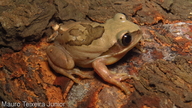|
Leptopelis mossambicus Poynton, 1985
Mozambique Tree Frog, Isele lasezihlahleni elinsundua (Zulu) | family: Arthroleptidae genus: Leptopelis |
| Species Description: Poynton, J. C. 1985. Nomenclatural revision of southeast African treefrogs of the genus Leptopelis (Amphibia: Hyperoliidae). South African Journal of Science 81: 466–468. | |
 © 2018 Mauro Teixeira Jr (1 of 3) |
|
|
|
Description The tadpole is dark and elongated, up to 60 mm (18+42) in length. Tooth formula 1,3+3/3. Distribution and Habitat Country distribution from AmphibiaWeb's database: Malawi, Mozambique, South Africa, Swaziland, Zimbabwe
Life History, Abundance, Activity, and Special Behaviors Comments This account was taken from "Treefrogs of Africa" by Arne Schiøtz with kind permission from Edition Chimaira publishers, Frankfurt am Main.
References
Phaka, F.M., Netherlands, E.C., Kruger, D.J.D., Du Preez, L.H. (2019). Folk taxonomy and indigenous names for frogs in Zululand, South Africa. J Ethnobiology Ethnomedicine 15, 17. [link] Schiøtz, A. (1999). Treefrogs of Africa. Edition Chimaira, Frankfurt am Main. Originally submitted by: Arne Schiøtz (first posted 2001-02-12) Edited by: Kellie Whittaker (2023-05-31) Species Account Citation: AmphibiaWeb 2023 Leptopelis mossambicus: Mozambique Tree Frog <https://amphibiaweb.org/species/5711> University of California, Berkeley, CA, USA. Accessed May 31, 2025.
Feedback or comments about this page.
Citation: AmphibiaWeb. 2025. <https://amphibiaweb.org> University of California, Berkeley, CA, USA. Accessed 31 May 2025. AmphibiaWeb's policy on data use. |



 Map of Life
Map of Life